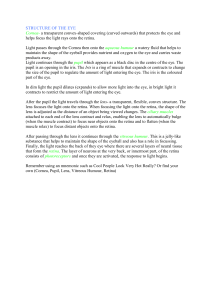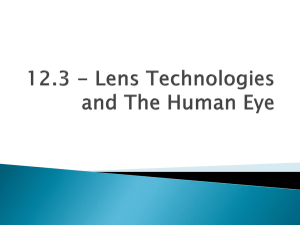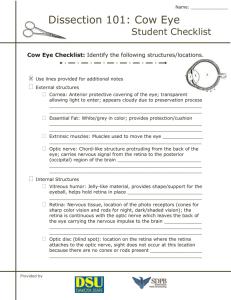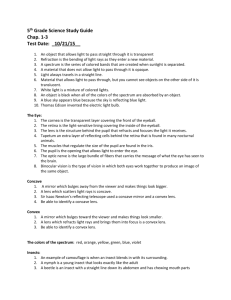Vision: photoreceptor cells in eye 3 grps of
advertisement
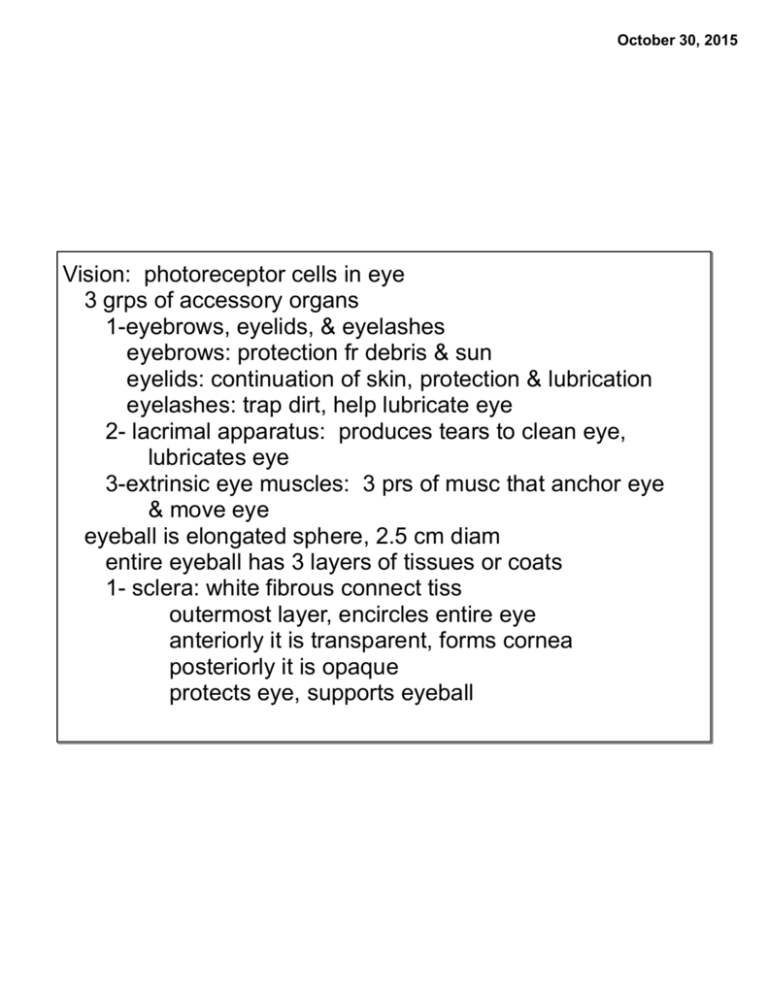
October 30, 2015 Vision: photoreceptor cells in eye 3 grps of accessory organs 1-eyebrows, eyelids, & eyelashes eyebrows: protection fr debris & sun eyelids: continuation of skin, protection & lubrication eyelashes: trap dirt, help lubricate eye 2- lacrimal apparatus: produces tears to clean eye, lubricates eye 3-extrinsic eye muscles: 3 prs of musc that anchor eye & move eye eyeball is elongated sphere, 2.5 cm diam entire eyeball has 3 layers of tissues or coats 1- sclera: white fibrous connect tiss outermost layer, encircles entire eye anteriorly it is transparent, forms cornea posteriorly it is opaque protects eye, supports eyeball October 30, 2015 3 tissue layers of eyeball 2-choroid coat: middle layer, contains blood vessels anteriorly forms iris, pupil, ciliary body posteriorly dark pigment, absorbs stray light rays, also nourishes retina 3-retina: innermost layer of eye thin membrane containing photoreceptors attached anteriorly to ciliary body attached posteriorly to optic nerve only 2 attachmts, can become loosened, problem eye parts from anterior to posterior cornea: tough membrane through which light is admitted to e part of sclera (tough connect tiss) but clear, protects eye refracts light rays aqueous humor: anterior chamber of eye, watery fluid btw cornea & iris, protects eye, helps eye keep shape, refracts light rays October 30, 2015 eye parts, anterior to posterior iris: colored part of eye, surrounds pupil, anterior to lens, formed from choroid layer, regulates the size of pupil, protects eye from intense light pupil: black circular opening in center of iris, admits light into eye ciliary body: part of choroid layer, holds lens in place, allows lens to accommodate lens: hard, but flexible oval, refracts & focuses light rays on retina, divides eye into anterior & posterior parts vitreous humor: jellylike fluid filling posterior chamber of eye, helps eyeball keep its shape, refracts light rays retina: innermost layer, contains photoreceptive cells, rods & cones, sends light info to brain rods: photoreceptor cells on retina, responsible for black & white vision, function in low light levels cones: photoreceptor cells on retina, responsible for color vision, function in high light levels October 30, 2015 eye parts fovea centralis: depression on retina, area of greatest concentration of cones, greatest visual acuity optic nerve: exits eye posteriorly, carries light info to brain there are no rods nor cones at spot where nerve exits eye so this a blind spot tapetum lucidum: a beautiful layer of choroid only seen in animals w/night vision, reflective layer that improves night vision October 30, 2015 Vision Physiology Focusing: to form images, light must land on photorecept cells on retina lens refracts (bends) light rays to land on retina cornea, aqueous humor, vitreous humor also refract light rays lens also changes shape to focus rays on retina normal eyeball is optimal shape for light to land on retina to focus on distant objects, lens is flattened, relaxed to focus close up, lens must be rounded we evolved for optimal sight distance to be 20ft away thus eye charts measure fr. 20ft near-sightedness, myopia: due to elongated eyeball can see close objects, but can't see letters 20 ft away lens focuses in front of retina for distant obj concave lens fixes problem October 30, 2015 far-sightedness, hyperopia: due to shortened eyeball can see distant, but not close up lens focuses light rays behind retina convex lens fixes problem accomodation: ability of the lens to change shape when viewing things up close when viewing close objects, ciliary musc contracts, lens becomes more convex, rounded when viewing distant objects, ciliary musc relaxes, lens flattens as you age, the lens loses its elasticity, can't round up for close viewing photopupillary reflex when light entering the eye is intense, circular musc of iris contracts, size of pupil decreases when light entering eye is dim, circ musc of iris relaxes allowing more light in, size of pupil increases October 30, 2015 convergence reflex: as object being viewed moves closer to eyes, eyeballs move medially in order for light rays to strike equivalent spots on retina Eye problems astigmatism: uneven cornea, dips in cornea light rays aren't evenly focused fuzzy areas in field of view glaucoma: buildup of fluid in anterior chamber due to duct blockage pressure compresses arteries that serve retina nerve fibers can die, blindness can result

